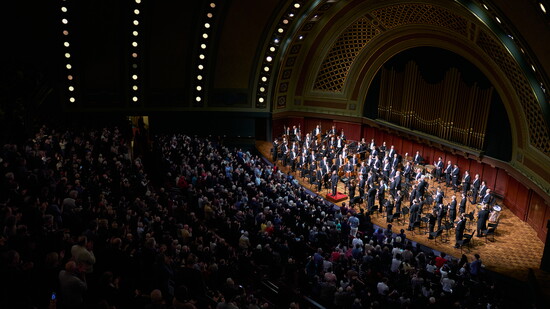Ann Arbor has had a reputation as a cultural haven for more than a century—an identity shaped, in no small part, by the University Musical Society. For nearly 150 years, UMS has defined the artistic life of the city by bringing a mix of global masterworks, genre-defying performances, marquee names, and rising experimental voices.
Founded in 1879, UMS is one of the oldest performing arts presenters in the country. It’s undeniable that the wide range of performances it brings to Ann Arbor has impacted the city’s cultural identity. And UMS, in turn, has been led by the audience’s curiosity and appetite.
“We have this kind of perfect combination of factors here,” says UMS President Matthew VanBesien. “A university town, a highly engaged public, a culture that values the arts and really understands how the arts can improve the overall quality of life. It makes this community a really special place.”
VanBesien, who joined UMS in 2017, recalls a moment after a 2022 performance by the Berlin Philharmonic. Kirill Petrenko, the orchestra’s famously reserved chief conductor, emerged from his dressing room and quietly grabbed VanBesien’s arm. “This is a great audience,” he said, before walking away. For a conductor known more for precision than praise, it was a striking endorsement. “And that’s what we hear again and again from artists,” VanBesien says. “This place is different.”
This fall, UMS will continue that tradition as it opens its 147th season with a thread of programming tied to America’s upcoming semiquincentennial. Rather than mount a spectacle, the organization is marking the milestone through performances that reflect on American identity, music, and culture. Highlights include a new symphony by Wynton Marsalis performed with the University Symphony Orchestra, a centennial tribute to Miles Davis and John Coltrane led by Terence Blanchard and Ravi Coltrane, and a full staging of the Martha Graham Dance Company’s centennial season.
The lineup also includes Indigenous-led work, like the Julia Keefe Indigenous Big Band and Nigamon/Tunai, an immersive theatrical piece rooted in the presence of the natural world. And then there’s Gatz, an eight-hour Gatsby marathon from theatre troupe Elevator Repair Service.
UMS’s Vice President of Marketing and Communication Sara Billmann says works like Gatz capture the kind of programming risks UMS is uniquely positioned to take. “It’s a commitment,” she says. “For the artists and for the audience. But that’s the kind of experience people here value. They’ll show up for something long, something bold, if it means being part of a meaningful moment.”
That kind of dynamic, variable programming is possible because of the audience, yes, but also because UMS doesn’t operate out of just a single venue. Instead, it works across campus and the region, using whatever space best suits the work—Hill Auditorium, the Power Center, Rackham, smaller clubs, even venues in Detroit. Hill remains the iconic flagship, and its acoustics and historical legacy are unmatched.
“It’s just really fun to sit in a seat and think about all of the artists who have been in that space for the last 110 years,” Billmann says. “Rachmaninoff, Stravinsky, Yasha Heifetz—legendary musicians who are practically household names.”
But UMS is also betting on more flexible and informal settings like the Ypsi Freighthouse, a city-owned space in downtown Ypsilanti activated with performances, family events, and workshops. Cayenne Harris, UMS’s Vice President of Learning & Engagement, says the series is “one of the most joyful and meaningful ways we connect with Southeast Michigan. We’re intentionally building programming that feels rooted in Ypsilanti’s creative energy.”
That sense of precision and care for the legacy and the community comes through in how the UMS team talks about its work. Marketing Manager Lilian Varner says, “It’s hard to encapsulate UMS in one phrase. The programming is dynamic, yes, but what really makes it work is the relationship with the audience. They are curious and they push us in new directions. We try to surprise them, and they walk away thinking about a performance for weeks.”
UMS turns 150 in 2029, and planning is already underway. VanBesien says that milestone will be as much about looking ahead as honoring the past. “We talk a lot about innovation because it’s been a part of history since the beginning. But it’s not about flash. It’s about being responsive and thoughtful, and deeply invested in what this region needs.”
Over nearly a century and a half, UMS has helped make Ann Arbor a city where global artistry isn’t just welcomed—it’s expected. From the world’s most storied orchestras to experimental theater and community-driven work in venues like Ypsi Freighthouse, UMS has created a cultural infrastructure as diverse as the city it serves. And the foundation is solid enough to last another 150 years.
To learn more and support the arts in Ann Arbor, visit ums.org
